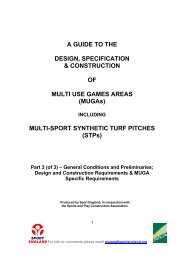View - North East Lincolnshire Council
View - North East Lincolnshire Council
View - North East Lincolnshire Council
Create successful ePaper yourself
Turn your PDF publications into a flip-book with our unique Google optimized e-Paper software.
BOC Immingham Dissolved Acetylene Project Environmental Statement: Vol. 2 Main Text<br />
Assessment Step Description<br />
3 Environmental<br />
baseline<br />
A discussion of the existing conditions, services and physical<br />
natural environment of the site and its surroundings. This includes<br />
consideration of sensitivity and importance of the existing<br />
environmental conditions (as appropriate).<br />
4 Potential impacts Identification and evaluation of the proposed Dissolved Acetylene<br />
Project’s potential impacts in quantitative and qualitative terms.<br />
Impacts have been considered in terms of direct or indirect, shortterm,<br />
medium-term or long-term, permanent or temporary,<br />
positive or negative effects.<br />
5 Assessment and<br />
significance of effects<br />
Following the identification of potential impacts (Step 4), the<br />
environmental baseline data (Step 3) have been used to predict<br />
any changes to the existing conditions and to allow an<br />
assessment of these changes.<br />
The assessment of a potential impact takes into account any<br />
methods to reduce the impact that are already incorporated into<br />
the design and assumes that ‘good practice’ will be applied.<br />
For impacts relating to emissions (e.g. noise, stack gases), a<br />
‘source-pathway-receptor’ viii approach has been taken to<br />
determine whether the identified potential impacts could result in<br />
an environmental effect.<br />
The effect that a project may have on each type of environmental<br />
receptor is influenced by the sensitivity of the baseline<br />
environment and the predicted degree of alteration from the<br />
baseline state.<br />
Significance of an impact has been evaluated in terms of the<br />
magnitude of impact and sensitivity of the receptor. For impacts<br />
effects where an assessment of significance cannot be<br />
determined (e.g. for reasons of uncertainty) this issue has been<br />
highlighted and an explanation given as to why this is the case.<br />
Criteria (as identified in Step 2) have been used in the<br />
assessment process to define the significance of effects. Specific<br />
criteria have been defined in each impact assessment chapter but<br />
are generally considered as:<br />
Major: substantial fundamental changes in an ecosystem ix ,<br />
society, or economy. Changes are well outside the range of<br />
natural variation and unassisted recovery could be protracted.<br />
Moderate: a material but non-fundamental change in an<br />
ecosystem, society, or economy. Changes may exceed the range<br />
of natural variation. Recovery could occur in the long-term.<br />
Minor: a detectable but non-material change in an ecosystem,<br />
society or economy. Changes might be noticeable, but fall within<br />
the range of normal variation.<br />
Negligible: changes in an ecosystem, society, or economy that<br />
are unlikely to be noticeable (i.e. well within the scope of natural<br />
variation).<br />
viii The source-pathway-receptor approach typically involves an estimate of the quantity and composition of material which could escape<br />
(source), the routes by which it could travel offsite (pathways) and the environmental sensitivity of the receiving environment (receptors).<br />
For there to be an environmental effect all three linkages must be present. If connecting source-pathway-receptor linkages cannot be<br />
identified then there is no environmental effect and no need to progress further with the environmental assessment.<br />
ix The term ‘ecosystem’ can be taken to mean the physical environment and the biological communities that live within that environment.<br />
Typically impacts to biological populations and communities are considered rather than impacts to individuals.<br />
5100935.404 Environmental Statement August 2011 56




